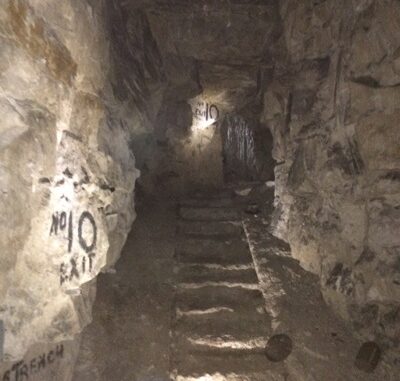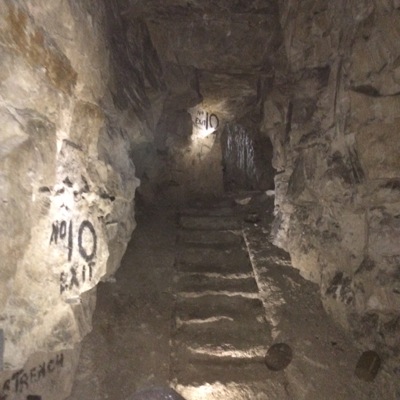
‘They are young, far too young’, French journalist Jules Mathon on the British soldiers at the Battle of Arras.
If you think the London Underground can be a claustrophobic squeeze, imagine being one of 24,000 soldiers crammed into a dark, underground quarry near Arras in Northern France. La Carrière Wellington (The Wellington Quarry) takes cramped living conditions to a frightening new level.
In 1916 the Allies had spotted the surprise-attack potential of the tunnels and quarries that led from British-held Arras under No Man’s Land towards the German lines. The 500 men of the New Zealand Tunnelling Company connected the different tunnels and quarries, sometimes tunnelling a boggling (and frankly unbelievable but for the fact I read it in the official guide) eighty metres a day. They finished the tunnels a metre or so from the surface, the idea being that at Zero Hour explosions would shift the remaining rock and the Allied soldiers would pour out whilst the Germans were still abed.

No.10 exit from the Wellington Quarry up which the soldiers climbed on Easter Monday, 1917
The total underground network stretched for 12 miles, in which there was room to house 4000 men in three-tier bunk beds. That seems like a squash and a squeeze, but for eight days in 1917 it was home to 24,000 men. That’s two thousand squaddies every half mile, giving each man 80 centimetres of tunnel. For them and their kit. For eight days and nights. The horror is hard to imagine for a generation whose idea of suffering is to lose mobile reception for a few hours.
Part of the tunnels are open to the public and can be visited just outside Arras in the Nord-Pas de Calais. You are taken by lift twenty metres under the ground, wearing a jovial tin hat to protect your head, although the tunnels are generally very high and in some places soar like cathedral towers. The tunnels are dimly lit though fairly wide, as tunnels go. If you had to share a tunnel with 23,999 other people, these would definitely be the tunnels to chose.
Wearing headphones that magically start talking at various points you walk around the tunnels, watching projected films which tell the story the quarry played in the Battle of Arras and the wider First World War. The attack was supposed to be a diversion to allow the French to attack further south at Chemin des Dames. It was a controversial plan and General Haig thought it absurd. But the new French General Nivelle had friends in high places, including Lord Kitchener, so it went ahead.
The tunnel walls are painted with official numbers and directions to the nearest latrines but also include scratched names and ranks as well as pencil sketches and carvings. There is also proof that the British soldiers kept their sense of humour. Still visible on the wall towards the end of the tour is a small engraving of a woolly mammal.
Before being sent up the carved steps to the battlefield, the men were told to leave their coats behind. As it was freezing outside that wasn’t a message that things were expected to go well. And they didn’t. Although the first attack was positive, the commanders didn’t push on the advantage they had and gave the Germans time to reinforce. Over the next two months the British lost four thousand men…EVERY DAY. For that they gained 7 miles, which puts a price of 30,000 lives on each mile. To put those figures in perspective, the more famous victory at Vimy Ridge cost four thousand lives over 4 days.
The Wellington Quarry centre has a small cinema which shows a short film about the Battle of Arras, showing images of the destruction that the city suffered as a result of its frontline position. There is a space for contemporary artworks about the war, showing (when I visited) sculptures of wounded soldiers by Belgian artist John Bulteel.
Spending time in the quarry where 24,000 soldiers lived before being slaughtered is a sobering experience and is a good way to make history relevant. Our guide Francois said that visiting school children start off full of jabbering beans and end up silent. It’s a little cold 20 metres below ground, so bring a warm jumper or a coat. Unlike the soldiers you’ll be allowed to wear it when you leave, and you’ll get a lift to carry you back up to the surface.
And rather than German soldiers you’ll be met by a gift shop. We have it easy nowadays.
La Carrière Wellington runs regular guided visits daily for €6.80 per adult and €3.10 per child. To buy tickets, visit https://explorearras.getaticket.com/
More details about the Nord-Pas de Calais

Leave a Reply